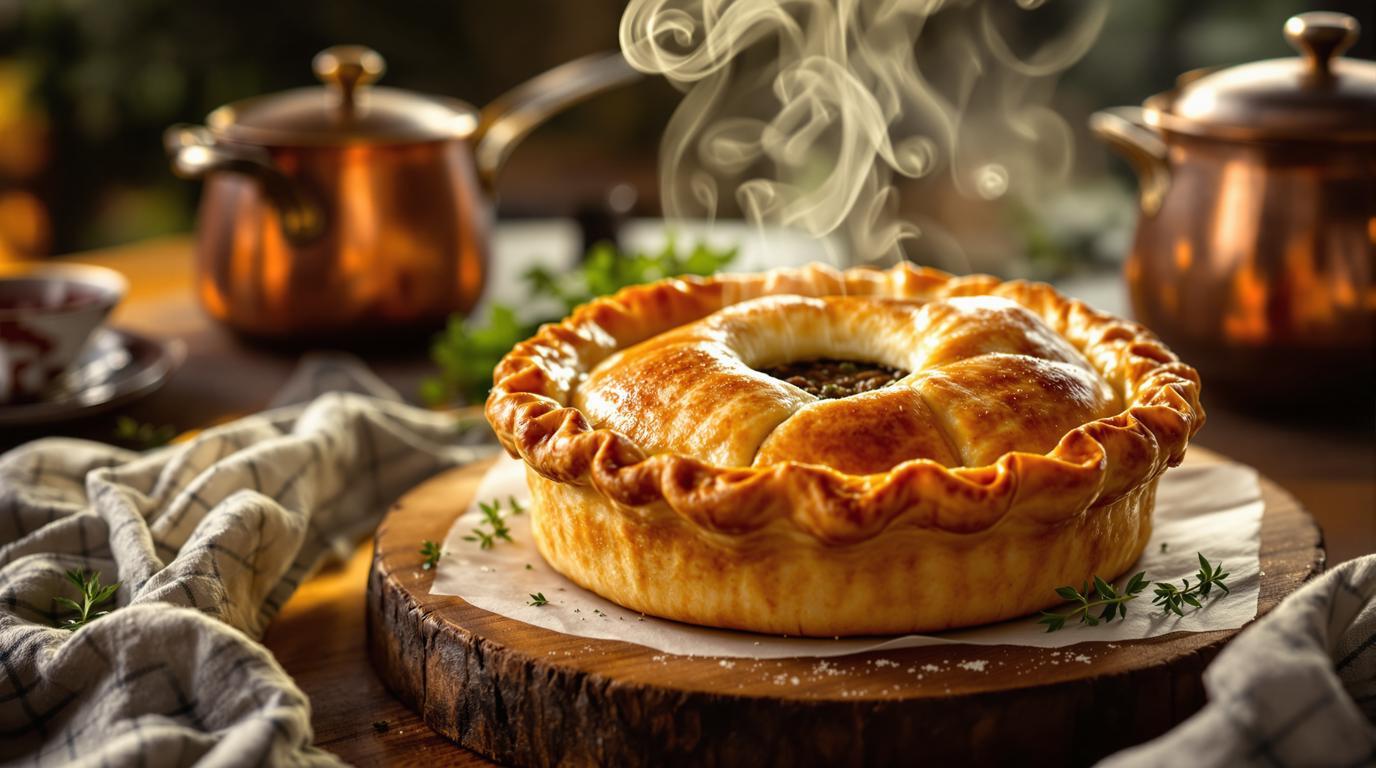I’ll never forget my first taste of authentic Tourtière, that traditional French-Canadian meat pie that appears on holiday tables throughout Quebec. I was a young apprentice working in Montreal, and my mentor Chef Pascal invited me to his grandmother’s home for réveillon, the Christmas Eve feast. The moment she lifted the golden-brown crust to reveal the aromatic beef filling beneath, I knew I’d discovered something special. Years later, I still make this beef ragout filling exactly as Grandmère Beauchamp taught me. The magic lies in the slow-braised beef and that perfect blend of warming spices that defines this classic dish. 🍂
The Heart of Tourtière: A Traditional Beef Ragout 🇨🇦
What makes this beef ragout so special is its connection to French-Canadian heritage. Dating back to the 18th century, settlers adapted traditional French braising techniques to the harsh Canadian winters, creating hearty, warming dishes from humble ingredients. The distinctive spice blend—featuring cinnamon, cloves and nutmeg—reflects both European tradition and indigenous influence, making each bite a true taste of culinary history. While many modern tourtières use ground meat for convenience, this slow-braised version delivers incomparable depth and richness. 🕰️
For an interesting twist on traditional beef ragout, try my Luxurious 3-Hour Oxtail Stew that transforms another forgotten cut into something extraordinary.
Essential Ingredients & Equipment 📋
For the ragout (fills 2 nine-inch pies):
- 2 pounds (900g) beef chuck or blade roast, cut into 1-inch cubes
- 2 tablespoons (30ml) neutral oil
- 2 medium onions, finely diced
- 1 large carrot, diced
- 2 celery stalks, diced
- 2 garlic cloves, minced
- 1 cup (240ml) full-bodied red wine
- 2 cups (480ml) beef stock or brown veal stock
- 1 tablespoon (15ml) all-purpose flour
- 2 sprigs fresh thyme
- 1 bay leaf
- ¼ teaspoon ground cinnamon
- ¼ teaspoon ground nutmeg
- 6 whole cloves, ground (or ⅛ teaspoon ground)
- Salt and freshly ground black pepper
Equipment: Heavy-bottomed Dutch oven or cast iron casserole with lid, wooden spoon, pastry crust for tourtière (purchased or homemade)
Creating the Perfect Beef Ragout 🔥
- Prepare the beef: Pat meat dry with paper towels (moisture is the enemy of proper browning). Season generously with salt and pepper.
- Sear the beef: Heat oil in Dutch oven over medium-high heat until shimmering. Working in batches to avoid crowding, sear beef on all sides until deep golden brown, about 3 minutes per batch. Remove to a plate.
- Build the flavor base: Reduce heat to medium. Add onions, carrots, and celery to the same pot. Cook until vegetables have softened and onions are translucent, about 5-7 minutes. Add garlic and cook 30 seconds until fragrant.
- Create your sauce: Sprinkle flour over vegetables and stir constantly for 1 minute. Gradually add wine, scraping up the flavorful browned bits from the bottom of the pot. Bring to a simmer and reduce by half, about 5 minutes.
- The gentle braise: Return beef to pot along with any accumulated juices. Add stock, thyme, bay leaf, and ground spices. Bring to a gentle simmer, then cover and transfer to a 325°F (160°C) oven for 2 hours, or until beef is fork-tender.
- Final touches: Remove from oven. If sauce needs thickening, simmer uncovered for 5-10 minutes. Taste and adjust seasoning with salt and pepper.
- Preparing for the pie: Allow ragout to cool completely before filling your tourtière pastry. The flavors will deepen as it rests.
Chef’s Note: The key to this ragout’s extraordinary flavor is proper browning. Don’t rush this step. Take your time developing that deep color on the beef—it’s creating layers of flavor that can’t be added later. My grandmother always said, “Les bons ragoûts commencent par une bonne coloration.” (Good stews begin with good coloring.)
Secret Techniques for Authentic Flavor 🤫
Unlike quick-cooking ground meat fillings, this slow-braised ragout develops profound flavor through gentle cooking. The secret lies in two crucial techniques: first, thoroughly browning the meat creates the Maillard reaction—those complex flavor compounds that form the foundation of the dish. Second, the patient breakdown of tough collagen into gelatin during the slow braise not only tenderizes the meat but creates that silky, rich mouthfeel that defines a proper ragout.
If you appreciate the transformative power of slow-cooking techniques, you might also enjoy my recipe for Southern Soul in a Bowl: Smoky Pork and Black-Eyed Peas.
Serving & Variations 🍽️
Traditionally, this ragout fills a tourtière (double-crust pie), baked until golden at 375°F (190°C) for about 35 minutes. Serve warm with a side of cranberry sauce or pickled beets for the perfect sweet-tart contrast to the rich filling.
For a lighter option, try serving the ragout over mashed potatoes or alongside roasted vegetables. Looking for vegetarian alternatives? My Smoky BBQ Cauliflower Steaks offer a satisfying meatless option with similar depth of flavor.
Don’t have beef chuck? Boneless short ribs or stewing veal make excellent substitutes. And for those short on time, try my 30-Minute Zesty Chicken Tacos that deliver big flavor in less time.
There’s something profoundly satisfying about connecting with culinary traditions through dishes like this ragout. When I serve tourtière filled with this slow-braised beef, I’m not just offering nourishment—I’m sharing history, culture, and the cooking wisdom passed down through generations. That, to me, is what makes cooking such a meaningful experience. Now it’s your turn to create this delicious tradition in your own kitchen. Bon appétit! 🍴
